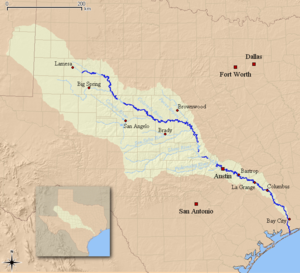 The Colorado River of Texas flows nearly due southeast through some of the most storied lands in Texas history. One of relatively few sources of fresh water in this dry region, the Colorado River was the home of the earliest Native American tribes in Texas. Early pioneers depended on the river for water and a transportation route to the inland as well, causing small towns to spring up on its banks. Comanches dominated the Colorado Rivers area for decades, often using the Colorado River as a starting point for their raids into Mexico during the early 1800's. In 1839 Austin was named the capital of the fledgling Republic of Texas, in part because its location on the Colorado Rivers allowed easy transportation and access to natural resources.
The Colorado River of Texas flows nearly due southeast through some of the most storied lands in Texas history. One of relatively few sources of fresh water in this dry region, the Colorado River was the home of the earliest Native American tribes in Texas. Early pioneers depended on the river for water and a transportation route to the inland as well, causing small towns to spring up on its banks. Comanches dominated the Colorado Rivers area for decades, often using the Colorado River as a starting point for their raids into Mexico during the early 1800's. In 1839 Austin was named the capital of the fledgling Republic of Texas, in part because its location on the Colorado Rivers allowed easy transportation and access to natural resources.In its natural state the Colorado Rivers had an extremely variable water level. In some areas, it was barely more than a stream; in others, destructive floods caused loss of life and property damage. Buchanan Dam and the resulting reservoir were designed as an attempt to control the flow of water and produce reliable electrical power. The original plan for the Buchanan dam was drawn up in the 1850's, but due to financial constraints and financial setbacks, it was not actually completed until 1937. Inks Dam was completed in 1938 not far downstream, and soon these dams provided not only water but hydroelectric power to the areas surrounding the Colorado River.
Eleven major dams and reservoirs along the Colorado Rivers provide water and power for Texas residents. Responsibility for these river projects falls to the Upper Colorado River Authority (UCRA) and the Lower Colorado River Authority (LCRA), nonprofit organizations created by the Texas Legislature in the 1930's to serve the water and power needs of the growing state. The UCRA is best known as a lending institution for local cities, providing funds for water reclamation projects and other conservation concerns and overseeing environmental programs as they pertain to the Colorado River. The LCRA holds responsibility for the operations at the Buchanan, Inks, Wirtz, Max Starcke, Mansfield and Tom Miller dams and reservoirs, collectively known as the Texas Highland Lakes. Additionally, the LCRA manages several state utility projects that provide water, electricity, and other public services to Central and Southeast Texas. Over one million residents of this area derive most or all of their electricity from projects administered by the LCRA.
During the 1970's and 1980's, Austin experienced a sharp growth in population. This necessitated an increase in construction, and the resulting pollution threatened to damage the water quality of the Colorado River. City and state officials took prompt action, expanding water treatment facilities and instituting strict new rules to defend the Colorado against further pollution. Today, the Colorado River Trail Program attracts visitors from across the country and around the globe. Kayak and canoe trips down the Colorado are tailor-made for novice paddlers due to the slow current of the river and the wide variety of wildlife that can be spotted along the banks of the river. The Highland Lakes are especially popular tourist attractions with over a million visitors each year. The Colorado River in Texas truly delivers the best of both worlds: water and electricity for the region, and a beautiful and unspoiled destination for tourists everywhere.

0 comments
Post a Comment